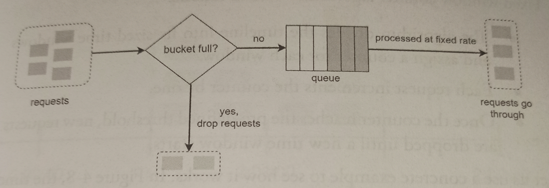Leaking Bucket
- Overview
- Pros
- Cons
Overview
Shopify uses leaky buckets for rate-limiting.

-
When a request arrives, the system checks if the queue is full. If it is not full, the request is added to the queue. Otherwise, the request is dropped. Requests are pulled from the queue and processed at regular intervals.
- It takes two parameters:
- Bucket size: It is equal to the queue size. The queue holds the requests to be processed at a fixed rate.
- Outflow rate: It defines how many requests can be processed at a fixed rate, usually in seconds.
-
Similar to the Token Bucket algorithm except that requests are processed at a fixed rate.
- It is usually implemented with a FIFO queue.
Pros
-
Memory efficient given the limited queue size.
-
Requests are processed at a fixed rate and therefore it is suitable for use cases that a stable outflow rate is needed.
Cons
-
A burst of traffic fills up the queue with old requests, and if they are not processed in time, recent requests will be rate limited.
-
It might not be easy to tune bucket size and outflow rates parameters properly.